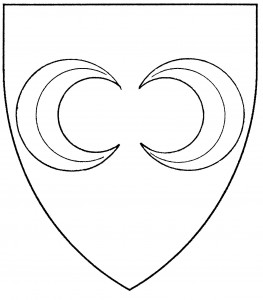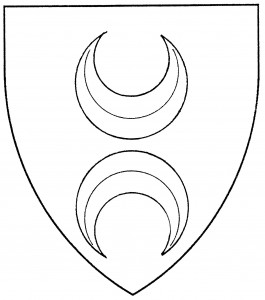The crescent is an ancient charge, shaped like the quarter-moon just after new. It’s thought to have been intended originally as a horse-brass; but it quickly gained its present lunar interpretation. It’s found as early as c.1244, in the canting arms of de Cressy [Asp2 215].
The crescent has its horns to chief by default. If the horns point to base, it is blazoned a “crescent pendant (or pendu)” or “crescent inverted”; this form is seen in the arms of Pope Benedict XIII, 1394 [Conz.Const. lxxv]. If the horns point to sinister, it’s blazoned a “decrescent”; if to dexter, an “increscent”.
In Society heraldry, the use of a red descrescent on a white background, by itself or in combination with other motifs, has been restricted due to its use as the symbol of the International Red Crescent, which is protected by mundane international law.
In the English system of cadency, the crescent is the mark of the second son. In medieval times, it was sometimes used to represent the Turks or the Moslems. For related charges, see moon. See also heavenly bodies.
The King of Caid bears: Azure, a crown within a laurel wreath Or, between three crescents within a bordure embattled argent.
Saher de Wahull bears: Or, three crescents gules.
Sean Macarailt of Sandyhume bears: Sable, an increscent argent.
Arqai Ne’ürin bears: Gyronny sable and argent, a decrescent vert.
Fiona Ann the Fair bears: Ermine, three crescents inverted sable.

